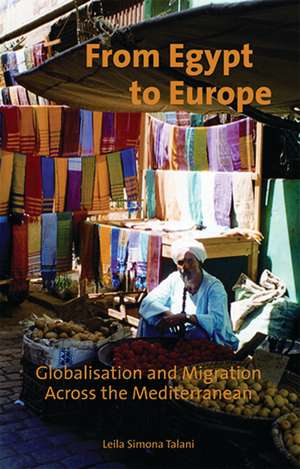From Egypt to Europe: Globalisation and Migration Across the Mediterranean
Autor Leila Simona Talanien Limba Engleză Hardback – 20 dec 2009
Preț: 773.26 lei
Preț vechi: 1112.62 lei
-31% Nou
Puncte Express: 1160
Preț estimativ în valută:
147.96€ • 155.31$ • 122.81£
147.96€ • 155.31$ • 122.81£
Carte tipărită la comandă
Livrare economică 11-25 aprilie
Preluare comenzi: 021 569.72.76
Specificații
ISBN-13: 9781845116699
ISBN-10: 1845116690
Pagini: 288
Ilustrații: Illustrations
Dimensiuni: 138 x 216 x 30 mm
Greutate: 0.49 kg
Editura: Bloomsbury Publishing
Colecția I.B.Tauris
Locul publicării:London, United Kingdom
ISBN-10: 1845116690
Pagini: 288
Ilustrații: Illustrations
Dimensiuni: 138 x 216 x 30 mm
Greutate: 0.49 kg
Editura: Bloomsbury Publishing
Colecția I.B.Tauris
Locul publicării:London, United Kingdom
Notă biografică
Dr Simona Talani is a Lecturer in European Political Economy at the University of Bath, and a Research fellow at the London School of Economics.
Cuprins
Introduction Chapter 1. Migration in theory: The state of the debate or the State in the debate? 1.1. Introduction 1.2. What is International Political Economy? 1.3. Mainstream versus critical IPE approaches: The State in thedebate 1.3.1 The political economy of immigration in the realisttradition 1.3.2 Liberal institutionalism and migration 1.3.3 The globalisation thesis: An introduction Chapter 2. The globalisation thesis within the globalisation debate 2.1. Introduction 2.2. A qualitative definition of globalisation 2.2.1 Globalisation and the State 2.2.1.1 Realist approaches: The globalisation myth andthe centrality of the State 2.2.1.2. Neo-institutionalist approaches: The transformation of the nation state in the global economy 2.2.1.3 Transnationalist approaches: The subordination of politics to economics 2.3. The new global division of labour and the increase of mass migration 2.4. Conclusion Chapter 3. Fortress Europe 3.1. Introduction 3.2. The evolution of 'Fortress Europe' 3.3. EU immigration models 3.4. Conclusion Chapter 4. Migration in practice: Egyptians did not emigrate! 4.1. Introduction 4.2. The policy of the Egyptian government 4.3. Egypt's migration dynamics 4.4. Egyptian migration today 4.5. Mapping the routes 4.5.1 The Spanish route 4.5.2 The Libyan route 4.5.3 The Turkish route 4.5.4 The Sarajevo route 4.5.5 Egypt as a transit country 4.6. Conclusion Chapter 5. Why do Egyptians migrate now?: The lack of integration in the MENA region 5.1. Introduction 5.2. The institutional steps towards more economic integration in theMENA region 5.3. Actual economic integration in the MENA region 5.3.1 Intraregional trade integration 5.3.2 Inter-Arab aid capital flows 5.4. Conclusion Chapter 6. Why do Egyptians migrate now?: The marginalisation of Egypt6.1. Introduction6.2. Steps towards an open and stable economy6.3. The marginalisation of Egypt6.3.1 Economic marginalisation 6.3.2 Other indicators of marginalisation 6.4. Conclusion Chapter 7. Who is the Egyptian migrant? 7.1. Introduction 7.2. The profi le of the Egyptian migrant: The 'homo economicus' 7.3. The profi le of the Moroccan migrant: From the homo economicus to the community-formation phase 7.4. Conclusion Chapter 8. What do Muslim migrants do in receiving countries? 8.1. Introduction 8.2. The integration of Muslim workers in the labour markets: General patterns in Europe 8.3. Egyptians abroad: brain drain or mass migration? 8.4. The insertion of migrants in the 'informal economy' and its consequences for receiving societies 8.5. Conclusion Chapter 9. 'Islamophobia' and social capital 9.1. Introduction9.2. 'Muslim voices': The enemy within 9.3. Instances of 'Islamophobia' before September 11 9.4. What is social capital? 9.5. The consequences of the lack of social capital among immigrant Muslim communities: the case of France 9.6. Conclusion









